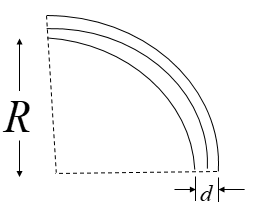
A bimetallic strip is formed out of two identical strips, one of copper and the other of brass. the coefficients of linear expansion of the two metals are ${{\alpha }_{c}}$and ${{\alpha }_{b}}$(${{\alpha }_{b}}>{{\alpha }_{c}}$). On heating the bimetallic strip through temperature $\Delta T$, the strip bends into an arc of a circle. find the radius of curvature of the strip
A. $R=\dfrac{2d}{\left( {{\alpha }_{b}}-{{\alpha }_{c}} \right)\Delta T}$
B. $R=\dfrac{3d}{({{\alpha }_{b}}-{{\alpha }_{c}})\Delta T}$
C. $R=\dfrac{d}{({{\alpha }_{b}}-{{\alpha }_{c}})\Delta T}$
D. $R=\dfrac{d}{2({{\alpha }_{b}}-{{\alpha }_{c}})\Delta T}$
Answer
576.9k+ views
Hint: Bimetallic strips are strips consisting of two different metals having different temperature coefficients. They expand or contract whenever there is change in temperature. Their expansion is governed by a basic law.
Formula used:
$l={{l}_{0}}(1+\alpha \Delta T)$
$l=R\theta $
Complete step by step answer:
Let us consider a strip as described in the question. Let the first layer of the bimetallic strip be of copper and the second layer on the bimetallic strip be of brass. Also, consider the width of the bimetallic strip be $d$.
As we heat the bimetallic strip, it heats up, bends and gets formed into the shape of an arc as shown in the figure.

Let the arc formed be a part of a circle with radius $R$
As we know, for a given material, it can be written as
$l={{l}_{0}}(1+\alpha \Delta T)$
Here, the initial length of both the copper and brass layers is the same. Let it be ${{l}_{0}}$
Thus, for copper strip: ${{l}_{c}}={{l}_{0}}(1+{{\alpha }_{c}}\Delta T)$ ---(i)
For brass strip: \[{{l}_{b}}={{l}_{0}}(1+{{\alpha }_{b}}\Delta T)\] ---(ii)
Also, as they are a part of the arc of a circle, we can say that
Arc length = Radius * angle subtended
Thus, for copper:
${{l}_{c}}=R\theta $ ----(iii)
And for brass:
${{l}_{b}}=\left( R+d \right)\theta $ ----(iv)
From equation (i) and (iii)
$R\theta ={{l}_{0}}(1+{{\alpha }_{c}}\Delta T)$ ----(v)
Also, from equation (ii) and (iv)
$(R+d)\theta ={{l}_{0}}(1+{{\alpha }_{b}}\Delta T)$ ----(vi)
Now, (vi)/ (v):
\[\dfrac{(R+d)\theta }{R\theta }=\dfrac{{{l}_{0}}(1+{{\alpha }_{b}}\Delta T)}{{{l}_{0}}(1+{{\alpha }_{c}}\Delta T)}\]
\[\Rightarrow \dfrac{(R+d)}{R}=(1+{{\alpha }_{b}}\Delta T){{(1+{{\alpha }_{c}}\Delta T)}^{-1}}\]
Using Binomial theorem, ${{(1+at)}^{-1}}=1-at$
Here, we get:
\[\Rightarrow \dfrac{(R+d)}{R}=(1+{{\alpha }_{b}}\Delta T)(1-{{\alpha }_{c}}\Delta T)\]
\[\Rightarrow 1+\dfrac{d}{R}=1+({{\alpha }_{b}}-{{\alpha }_{c}})\Delta T+\Delta {{T}^{2}}\]
Here, $\Delta {{T}^{2}}\to \text{very very small}$
So, we neglect it.
\[\Rightarrow \dfrac{d}{R}=({{\alpha }_{b}}-{{\alpha }_{c}})\Delta T\]
$\Rightarrow R=\dfrac{d}{({{\alpha }_{b}}-{{\alpha }_{c}})\Delta T}$
Thus, the correct option is (c).
Note:
Bimetallic strips are predominantly used in some thermostats to measure the change in temperature. Due to the presence of two different metals, they expand or contract at different rates causing the strip to bend. This bend indicates change in temperature.
Formula used:
$l={{l}_{0}}(1+\alpha \Delta T)$
$l=R\theta $
Complete step by step answer:
Let us consider a strip as described in the question. Let the first layer of the bimetallic strip be of copper and the second layer on the bimetallic strip be of brass. Also, consider the width of the bimetallic strip be $d$.
As we heat the bimetallic strip, it heats up, bends and gets formed into the shape of an arc as shown in the figure.

Let the arc formed be a part of a circle with radius $R$
As we know, for a given material, it can be written as
$l={{l}_{0}}(1+\alpha \Delta T)$
Here, the initial length of both the copper and brass layers is the same. Let it be ${{l}_{0}}$
Thus, for copper strip: ${{l}_{c}}={{l}_{0}}(1+{{\alpha }_{c}}\Delta T)$ ---(i)
For brass strip: \[{{l}_{b}}={{l}_{0}}(1+{{\alpha }_{b}}\Delta T)\] ---(ii)
Also, as they are a part of the arc of a circle, we can say that
Arc length = Radius * angle subtended
Thus, for copper:
${{l}_{c}}=R\theta $ ----(iii)
And for brass:
${{l}_{b}}=\left( R+d \right)\theta $ ----(iv)
From equation (i) and (iii)
$R\theta ={{l}_{0}}(1+{{\alpha }_{c}}\Delta T)$ ----(v)
Also, from equation (ii) and (iv)
$(R+d)\theta ={{l}_{0}}(1+{{\alpha }_{b}}\Delta T)$ ----(vi)
Now, (vi)/ (v):
\[\dfrac{(R+d)\theta }{R\theta }=\dfrac{{{l}_{0}}(1+{{\alpha }_{b}}\Delta T)}{{{l}_{0}}(1+{{\alpha }_{c}}\Delta T)}\]
\[\Rightarrow \dfrac{(R+d)}{R}=(1+{{\alpha }_{b}}\Delta T){{(1+{{\alpha }_{c}}\Delta T)}^{-1}}\]
Using Binomial theorem, ${{(1+at)}^{-1}}=1-at$
Here, we get:
\[\Rightarrow \dfrac{(R+d)}{R}=(1+{{\alpha }_{b}}\Delta T)(1-{{\alpha }_{c}}\Delta T)\]
\[\Rightarrow 1+\dfrac{d}{R}=1+({{\alpha }_{b}}-{{\alpha }_{c}})\Delta T+\Delta {{T}^{2}}\]
Here, $\Delta {{T}^{2}}\to \text{very very small}$
So, we neglect it.
\[\Rightarrow \dfrac{d}{R}=({{\alpha }_{b}}-{{\alpha }_{c}})\Delta T\]
$\Rightarrow R=\dfrac{d}{({{\alpha }_{b}}-{{\alpha }_{c}})\Delta T}$
Thus, the correct option is (c).
Note:
Bimetallic strips are predominantly used in some thermostats to measure the change in temperature. Due to the presence of two different metals, they expand or contract at different rates causing the strip to bend. This bend indicates change in temperature.
Recently Updated Pages
Master Class 11 Business Studies: Engaging Questions & Answers for Success

Master Class 11 Computer Science: Engaging Questions & Answers for Success

Master Class 11 Maths: Engaging Questions & Answers for Success

Master Class 11 Chemistry: Engaging Questions & Answers for Success

Master Class 11 Economics: Engaging Questions & Answers for Success

Master Class 11 Accountancy: Engaging Questions & Answers for Success

Trending doubts
What is meant by exothermic and endothermic reactions class 11 chemistry CBSE

10 examples of friction in our daily life

One Metric ton is equal to kg A 10000 B 1000 C 100 class 11 physics CBSE

1 Quintal is equal to a 110 kg b 10 kg c 100kg d 1000 class 11 physics CBSE

Difference Between Prokaryotic Cells and Eukaryotic Cells

What are Quantum numbers Explain the quantum number class 11 chemistry CBSE




